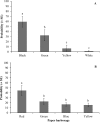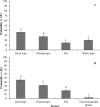Role of vision and mechanoreception in bed bug, Cimex lectularius L. behavior
- PMID: 25748041
- PMCID: PMC4351988
- DOI: 10.1371/journal.pone.0118855
Role of vision and mechanoreception in bed bug, Cimex lectularius L. behavior
Abstract
The role of olfactory cues such as carbon dioxide, pheromones, and kairomones in bed bug, Cimex lectularius L. behavior has been demonstrated. However, the role of vision and mechanoreception in bed bug behavior is poorly understood. We investigated bed bug vision by determining their responses to different colors, vertical objects, and their ability to detect colors and vertical objects under low and complete dark conditions. Results show black and red paper harborages are preferred compared to yellow, green, blue, and white harborages. A bed bug trapping device with a black or red exterior surface was significantly more attractive to bed bugs than that with a white exterior surface. Bed bugs exhibited strong orientation behavior toward vertical objects. The height (15 vs. 30 cm tall) and color (brown vs. black) of the vertical object had no significant effect on orientation behavior of bed bugs. Bed bugs could differentiate color and detect vertical objects at very low background light conditions, but not in complete darkness. Bed bug preference to different substrate textures (mechanoreception) was also explored. Bed bugs preferred dyed tape compared to painted tape, textured painted plastic, and felt. These results revealed that substrate color, presence of vertical objects, and substrate texture affect host-seeking and harborage-searching behavior of bed bugs. Bed bugs may use a combination of vision, mechanoreception, and chemoreception to locate hosts and seek harborages.
Conflict of interest statement
Figures




Similar articles
-
Behavioral Responses of Nymph and Adult Cimex lectularius (Hemiptera: Cimicidae) to Colored Harborages.J Med Entomol. 2016 Jul;53(4):760-769. doi: 10.1093/jme/tjw033. Epub 2016 Apr 25. J Med Entomol. 2016. PMID: 27113099
-
Effect of Feeding History and Time Elapsed From Field Collection on the Movement Behavior and Response to Stimulation in Cimex lectularius (Hemiptera: Cimicidae).J Econ Entomol. 2017 Aug 1;110(4):1719-1727. doi: 10.1093/jee/tox148. J Econ Entomol. 2017. PMID: 28541568
-
The odorant receptor co-receptor from the bed bug, Cimex lectularius L.PLoS One. 2014 Nov 20;9(11):e113692. doi: 10.1371/journal.pone.0113692. eCollection 2014. PLoS One. 2014. PMID: 25411789 Free PMC article.
-
Semiochemicals of the common bed bug, Cimex lectularius L. (Hemiptera: Cimicidae), and their potential for use in monitoring and control.Pest Manag Sci. 2011 Jan;67(1):10-20. doi: 10.1002/ps.2024. Epub 2010 Sep 21. Pest Manag Sci. 2011. PMID: 20859928 Review.
-
Bed bugs (Cimex lectularius) and clinical consequences of their bites.JAMA. 2009 Apr 1;301(13):1358-66. doi: 10.1001/jama.2009.405. JAMA. 2009. PMID: 19336711 Review.
Cited by
-
Behavioural Responses of Tropical Bed Bug Cimex hemipterus (F.) (Hemiptera: Cimicidae) to Coloured Harbourage.Trop Life Sci Res. 2024 Jul;35(2):271-288. doi: 10.21315/tlsr2024.35.2.13. Epub 2024 Jul 31. Trop Life Sci Res. 2024. PMID: 39234469 Free PMC article.
-
Genome of tropical bed bug Cimex hemipterus (Cimicidae, Hemiptera) reveals tetraspanin expanded in bed bug ancestor.Insect Sci. 2025 Feb;32(1):42-54. doi: 10.1111/1744-7917.13388. Epub 2024 Jun 3. Insect Sci. 2025. PMID: 38830803 Free PMC article.
-
Desiccant dust and the use of CO2 gas as a mobility stimulant for bed bugs: a potential control solution?J Pest Sci (2004). 2017;90(1):249-259. doi: 10.1007/s10340-016-0784-1. Epub 2016 Jun 20. J Pest Sci (2004). 2017. PMID: 28217039 Free PMC article.
-
Unique features of a global human ectoparasite identified through sequencing of the bed bug genome.Nat Commun. 2016 Feb 2;7:10165. doi: 10.1038/ncomms10165. Nat Commun. 2016. PMID: 26836814 Free PMC article.
-
The Behavioral Response to Heat in the Common Bed Bug, Cimex lectularius (Hemiptera: Cimicidae).J Med Entomol. 2021 Jul 16;58(4):1626-1637. doi: 10.1093/jme/tjab020. J Med Entomol. 2021. PMID: 33704449 Free PMC article.
References
-
- Allan SA, Day JF, Edman JD (1987) Visual ecology of biting flies. Annu Rev Entomol 32: 297–316. - PubMed
-
- Lehane MJ (1991) Biology of blood-sucking insects In: Lehane MJ, editor. London: Harper Collins Academic; pp. 288.
-
- Anderson JF, Ferrandino FJ, McKnight S, Nolen J, Miller J (2009) A carbon dioxide, heat and chemical lure trap for the bed bug, Cimex lectularius. Med Vet Entomol 23: 99–105. - PubMed
-
- Wang C, Gibb T, Bennett GW, McKnight S (2009) Bed bug (Heteroptera: Cimicidae) attraction to pitfall traps baited with carbon dioxide, heat and chemical lure. J Econ Entomol 102: 1580–1585. - PubMed
-
- Singh N, Wang C, Cooper R (2012) Interactions among non-chemical and chemical lures in attracting the bed bug, Cimex lectularius L. (Hemiptera: Cimicidae). Psyche. doi: 10.1155/2012/273613. - DOI
Publication types
MeSH terms
LinkOut - more resources
Full Text Sources
Other Literature Sources
Medical

